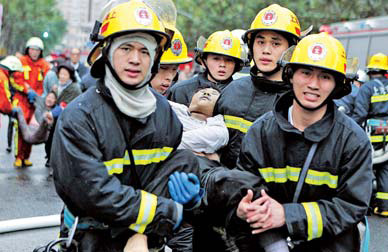Questions linger over inferno
He said that, as Jiayi's staff could not carry out the construction, the company was forced to rely on migrant workers on short-term contracts.
|
Fire rescue workers carry a survivor from the blaze in a residential tower block in Shanghai's Jing'an district. |
The State Council's investigation team discovered after the blaze that work to erect the scaffolding, install the energy-saving insulation material and reinforce aluminum windows had all been subcontracted to several smaller firms, which is illegal.
"Lax management has led to construction by multiple companies and the employment of unlicensed welders," said Luo Lin, director of the State Administration of Work Safety, who led the investigation. "It was the illegal construction that caused this terrible accident, which should not have happened and could have been avoided."
Luo vowed those responsible will be prosecuted.
Although authorities are required to select companies for projects worth more than 1 million yuan through a bidding process, there is no public record of Jiayi tendering for the recent work.
Jing'an district government is also yet to respond to claims in the media that Huang has close links with several local officials.
Foam dangerous?
Firefighters on the scene on Monday said the fire started when sparks from a welding torch ignited the bamboo scaffolding and nylon nets that surrounded the building.
However, residents have also blamed the energy-saving insulation material that was being installed.
A construction plan obtained by China Daily from Jiayi shows the company was using rigid polyurethane foam to improve the building's energy efficiency.
"Polyurethane foam plastic is inflammable. That is what turned the fire into a disaster," according to resident of a nearby building surnamed Bao told Xinhua News Agency.
In the same report, Xinhua detailed how Bao lit a piece of the yellow foam material with a lighter. It was entirely engulfed in flames within two seconds, producing thick, odorous smoke.
As insulation panels were also blamed for accelerating a blaze that gutted a building on the China Central Television complex in Beijing last year, there is now concern other buildings fitted with the material could also pose fire hazards.
Zhu Liping, a chief engineer with the Ministry of Public Security's fire department, explained that bamboo, nylon netting and polyurethane foam are all combustible and produce extremely harmful fumes.
He cited a 2008 nightclub fire in Shenzhen, Guangdong province, which killed 43 people and injured more than 80. It started when a stray firework ignited some polyurethane foam.
However, although inflammable, the foam can be modified to suit a variety of applications and to meet the national fire safety regulations. Rigid polyurethane foam is usually cut thinner than insulation materials, which means it would offer little fuel for a fire.
Tests on buildings containing rigid polyurethane foam insulation carried out in the United States and across Europe concluded that, if properly used, the material does not pose a serious hazard.
Building barriers
Experts in Hong Kong, meanwhile, pointed out the problem could have been more to do with the building's internal insulated structure.
"(The) material is not the key, it was the non-compatible structure between floors, which could prevent fire spreading internally, that mattered most," said Cheung K. P., an associate professor at the University of Hong Kong's department of architecture and an expert in the fire safety of tall buildings.
So far, much of the focus has been on the polyurethane, scaffolding and netting. However, Hong Kong experts have reservations.
"(Polyurethane foam) is also used in Hong Kong, although with lower frequency; bamboo scaffolding is also commonly used, however, not many fatal fires are reported here thanks to the thermal barrier placed on each floor," said Lim Wan-fung, a professor with the Chinese University of Hong Kong's school of architecture.
The thermal barrier is usually made up of insulating materials like steel sheets and can efficiently stop fires spreading to other floors, said Lim, who is also president of the Hong Kong Institute of Urban Design.
Thermal barriers are legally required on high-rise buildings in Hong Kong. A maxim 1-meter-thick inner layer of insulation material must be applied on the roof or between walls to isolate a potential fire, according to the website of the city's fire services department.
"If you take a look at the appearance of Hong Kong's residential buildings, you can't miss the concrete isolation between glass windows," said Cheung at the University of Hong Kong.
By looking at a picture of the Shanghai inferno, he said that the heavy smoke coming from the building's ground floor indicated lots of inflammable materials may have been placed in the lobby or around the building.
"This could fuel the fire by adding a 'barbecue effect'," added Cheung.
 0
0 







